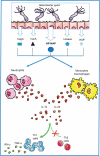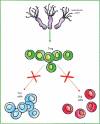The effect of Helicobacter pylori on asthma and allergy - PubMed (original) (raw)
The effect of Helicobacter pylori on asthma and allergy
Amedeo Amedei et al. J Asthma Allergy. 2010.
Abstract
Current evidence indicates an inverse association between Helicobacter pylori and asthma and allergy. H. pylori is a Gram-negative bacterium which represents the major cause of peptic ulcer and gastric cancer, and preferentially elicits a T helper (Th)-1 response. Many H. pylori factors, such as the neutrophil-activating factor of H. pylori (HP-NAP), are able to drive Th-1 polarization and to display a powerful inhibition of allergic Th-2 response. This article proposes an overview of the actual knowledge about the effects of H. pylori on asthma and allergy. Special attention has been drawn to HP-NAP as a potential novel strategy for the prevention and treatment of asthma and atopy.
Keywords: Helicobacter pylori neutrophil-activating factor; Th-1/Th-2; Treg; asthma; protein.
Figures
Figure 1
Schematic representation of _Helicobacter pylori-_driven inhibition of allergic Th-2 inflammation via activation of Th-1 responses. Following H. pylori infection, HP-NAP and other H. pylori factors induce the production of IL-12 and IL-23 that both promote the preferential development of Th-1 cells and repress the Th-2 allergic response. Abbreviations: HP-NAP, H. pylori neutrophil-activating protein; Th, T helper; IL, interleukin; IFN, interferon; TFN, tumor necrosis factor.
Figure 2
Inhibition of Th-2 response might hypothetically occur by _Helicobacter pylori_-induced activation of regulatory T cells. Abbreviations: Th, T helper; Treg, regulatory T cell.
Similar articles
- Helicobacter pylori, asthma and allergy.
D'Elios MM, Codolo G, Amedei A, Mazzi P, Berton G, Zanotti G, Del Prete G, de Bernard M. D'Elios MM, et al. FEMS Immunol Med Microbiol. 2009 Jun;56(1):1-8. doi: 10.1111/j.1574-695X.2009.00537.x. Epub 2009 Feb 10. FEMS Immunol Med Microbiol. 2009. PMID: 19220467 Review. - VacA and HP-NAP, Ying and Yang of Helicobacter pylori-associated gastric inflammation.
D'Elios MM, Montecucco C, de Bernard M. D'Elios MM, et al. Clin Chim Acta. 2007 May;381(1):32-8. doi: 10.1016/j.cca.2007.02.026. Epub 2007 Feb 21. Clin Chim Acta. 2007. PMID: 17368441 Review. - Detection and evaluation of antibodies against neutrophil-activating protein of Helicobacter pylori in patients with gastric cancer.
Long M, Luo J, Li Y, Zeng FY, Li M. Long M, et al. World J Gastroenterol. 2009 May 21;15(19):2381-8. doi: 10.3748/wjg.15.2381. World J Gastroenterol. 2009. PMID: 19452583 Free PMC article. - Helicobacter, Hygiene, Atopy, and Asthma.
Miftahussurur M, Nusi IA, Graham DY, Yamaoka Y. Miftahussurur M, et al. Front Microbiol. 2017 Jun 8;8:1034. doi: 10.3389/fmicb.2017.01034. eCollection 2017. Front Microbiol. 2017. PMID: 28642748 Free PMC article. Review.
Cited by
- Development of monoclonal antibody-based immunoassays for detection of Helicobacter pylori neutrophil-activating protein.
Iankov ID, Penheiter AR, Carlson SK, Galanis E. Iankov ID, et al. J Immunol Methods. 2012 Oct 31;384(1-2):1-9. doi: 10.1016/j.jim.2012.06.010. Epub 2012 Jun 28. J Immunol Methods. 2012. PMID: 22750540 Free PMC article. - Curcumin Oxidation Is Required for Inhibition of Helicobacter pylori Growth, Translocation and Phosphorylation of Cag A.
Ray AK, Luis PB, Mishra SK, Barry DP, Asim M, Pandey A, Chaturvedi M, Gupta J, Gupta S, Mahant S, Das R, Kumar P, Shalimar, Wilson KT, Schneider C, Chaturvedi R. Ray AK, et al. Front Cell Infect Microbiol. 2021 Dec 24;11:765842. doi: 10.3389/fcimb.2021.765842. eCollection 2021. Front Cell Infect Microbiol. 2021. PMID: 35004346 Free PMC article. - The Role of the Microbiome in Allergy, Asthma, and Occupational Lung Disease.
Peer A, Samuelson DR. Peer A, et al. Curr Allergy Asthma Rep. 2024 Aug;24(8):415-423. doi: 10.1007/s11882-024-01156-8. Epub 2024 Jun 21. Curr Allergy Asthma Rep. 2024. PMID: 38904934 Free PMC article. Review. - Helicobacter hepaticus cholesterol-α-glucosyltransferase is essential for establishing colonization in male A/JCr mice.
Ge Z, Feng Y, Muthupalani S, Whary MT, Versalovic J, Fox JG. Ge Z, et al. Helicobacter. 2014 Aug;19(4):280-8. doi: 10.1111/hel.12135. Epub 2014 May 23. Helicobacter. 2014. PMID: 24853076 Free PMC article. - The microbiome, HLA, and the pathogenesis of uveitis.
Rosenbaum JT, Lin P, Asquith M. Rosenbaum JT, et al. Jpn J Ophthalmol. 2016 Jan;60(1):1-6. doi: 10.1007/s10384-015-0416-y. Epub 2015 Sep 14. Jpn J Ophthalmol. 2016. PMID: 26370944 Review.
References
- Dijkstra L, Houthuijs D, Brunekreef B, et al. Respiratory health effects of the indoor environment in a population of Dutch children. Am Rev Respir Dis. 1990;142(5):1172–1178. - PubMed
- Matricardi PM, Rosmini F, Panetta V, et al. Hay fever and asthma in relation to markers of infection in the United States. J Allergy Clin Immunol. 2002;110(3):381–387. - PubMed
- Wickman M, Nordvall SL, Pershagen G, et al. House dust mite sensitization in children and residential characteristics in a temperate region. J Allergy Clin Immunol. 1991;88(1):89–95. - PubMed
LinkOut - more resources
Full Text Sources
Other Literature Sources
Research Materials
Miscellaneous

